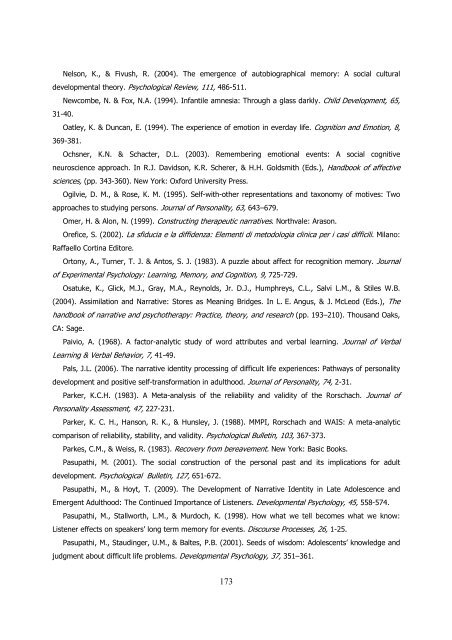LA NARRAZIONE AUTOBIOGRAFICA E IL FUNZIONAMENTO DEL SÉ
LA NARRAZIONE AUTOBIOGRAFICA E IL FUNZIONAMENTO DEL SÉ
LA NARRAZIONE AUTOBIOGRAFICA E IL FUNZIONAMENTO DEL SÉ
You also want an ePaper? Increase the reach of your titles
YUMPU automatically turns print PDFs into web optimized ePapers that Google loves.
Nelson, K., & Fivush, R. (2004). The emergence of autobiographical memory: A social cultural<br />
developmental theory. Psychological Review, 111, 486-511.<br />
Newcombe, N. & Fox, N.A. (1994). Infantile amnesia: Through a glass darkly. Child Development, 65,<br />
31-40.<br />
Oatley, K. & Duncan, E. (1994). The experience of emotion in everday life. Cognition and Emotion, 8,<br />
369-381.<br />
Ochsner, K.N. & Schacter, D.L. (2003). Remembering emotional events: A social cognitive<br />
neuroscience approach. In R.J. Davidson, K.R. Scherer, & H.H. Goldsmith (Eds.), Handbook of affective<br />
sciences, (pp. 343-360). New York: Oxford University Press.<br />
Ogilvie, D. M., & Rose, K. M. (1995). Self-with-other representations and taxonomy of motives: Two<br />
approaches to studying persons. Journal of Personality, 63, 643–679.<br />
Omer, H. & Alon, N. (1999). Constructing therapeutic narratives. Northvale: Arason.<br />
Orefice, S. (2002). La sfiducia e la diffidenza: Elementi di metodologia clinica per i casi difficili. Milano:<br />
Raffaello Cortina Editore.<br />
Ortony, A., Turner, T. J. & Antos, S. J. (1983). A puzzle about affect for recognition memory. Journal<br />
of Experimental Psychology: Learning, Memory, and Cognition, 9, 725-729.<br />
Osatuke, K., Glick, M.J., Gray, M.A., Reynolds, Jr. D.J., Humphreys, C.L., Salvi L.M., & Stiles W.B.<br />
(2004). Assimilation and Narrative: Stores as Meaning Bridges. In L. E. Angus, & J. McLeod (Eds.), The<br />
handbook of narrative and psychotherapy: Practice, theory, and research (pp. 193–210). Thousand Oaks,<br />
CA: Sage.<br />
Paivio, A. (1968). A factor-analytic study of word attributes and verbal learning. Journal of Verbal<br />
Learning & Verbal Behavior, 7, 41-49.<br />
Pals, J.L. (2006). The narrative identity processing of difficult life experiences: Pathways of personality<br />
development and positive self-transformation in adulthood. Journal of Personality, 74, 2-31.<br />
Parker, K.C.H. (1983). A Meta-analysis of the reliability and validity of the Rorschach. Journal of<br />
Personality Assessment, 47, 227-231.<br />
Parker, K. C. H., Hanson, R. K., & Hunsley, J. (1988). MMPI, Rorschach and WAIS: A meta-analytic<br />
comparison of reliability, stability, and validity. Psychological Bulletin, 103, 367-373.<br />
Parkes, C.M., & Weiss, R. (1983). Recovery from bereavement. New York: Basic Books.<br />
Pasupathi, M. (2001). The social construction of the personal past and its implications for adult<br />
development. Psychological Bulletin, 127, 651-672.<br />
Pasupathi, M., & Hoyt, T. (2009). The Development of Narrative Identity in Late Adolescence and<br />
Emergent Adulthood: The Continued Importance of Listeners. Developmental Psychology, 45, 558-574.<br />
Pasupathi, M., Stallworth, L.M., & Murdoch, K. (1998). How what we tell becomes what we know:<br />
Listener effects on speakers’ long term memory for events. Discourse Processes, 26, 1-25.<br />
Pasupathi, M., Staudinger, U.M., & Baltes, P.B. (2001). Seeds of wisdom: Adolescents’ knowledge and<br />
judgment about difficult life problems. Developmental Psychology, 37, 351–361.<br />
173

















